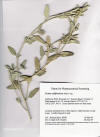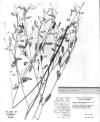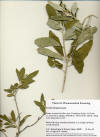|
Trees and
Shrubs of Kern County (Jan 2013)
Croton.
Usually perennial, herbs or shrubs or trees, often with resinous sap but
not milky latex, which is not evident in California species; hairs
usually present and branched; leaves mostly alternate, or appearing
nearly opposite or whorled in some species; flowers not in cyathia,
usually sessile or pedicelled on simple axillary or terminal scapes
(flower shoots, inflorescences); petals usually present in male flowers,
reduced or absent in female flowers; fruit as generally described for
the family, but in some species only one carpel matures. >1200 species,
usually a common constituent in most tropical and subtropical vegetation
types. 3 species in California, 1 in Kern County.
Croton californicus Mueller-Argovensis
1866. California croton. Subshrub of wiry stems not more than 50
cm high and broad; leaves covered with branched (stellate) hairs;
flowering Mar-Oct; flowers inconspicuous and falling off (without
petals, calyx 1–2 mm). Common in sandy places near the coast in southern
California north to the Bay Area, and in the deserts to southern Nevada,
Arizona and Baja California. Type from San Francisco, CA. Kern Co.
“Scarce...in the desert and along the east side of the valley from Sand
Ridge to Tejon Canyon” (Twisselmann). CCH— Mojave Desert: Rogers Lake,
southwest end of Edwards Air Force Base; Hwy 395 north of El Paso Mts.
San Joaquin Valley: Bakersfield; Sand Ridge; Tejon Creek Wash near
Arvin; Buttonwillow Ranch; Hwy 99 4.6 miles north of Maricopa. Tehachapi
Mts.: Ft. Tejon; Grapevine Creek. Sierra Nevada: Caliente Wash; near
Woodford; hot springs north of Kernville. 106–1006 m.
USDA ARS Procurement Records for Antitumor Active
Species of Croton.
Croton californicus
Croton punctatus
Memorandum on taxonomy of Croton punctatus, Aug, 2,
1973.
Croton texensis
Farnsworth N.
R., R. N. Blomster, W. M. Messmer, J. C. King, G. J. Persinos and J. D.
Wilkes. 1969. A phytochemical and biological review of the genus Croton.
Lloydia 32(1): 1–28.
Soejarto D.
D., A. D. Kinghorn and N. R. Farnsworth. 1977. Allergic
contact dermatitis from croton. Contact Dermatitis 3(5): 276.
Williams L.
3rd, P. E. Evans and W. S. Bowers. 2001. Defensive chemistry of an
aposematic bug, Pachycoris stallii Uhler and volatile compounds of
its host plant Croton californicus Muell.-Arg. “Volatile
components of Pachycoris stallii scent gland secretions and the
bug's host plant, Croton californicus, were identified by gas
chromatography and mass spectroscopy. The predominant compounds isolated
from C. californicus fruit and leaves were beta-myrcene and beta-caryophyllene.
Metathoracic gland secretions of P. stallii contained mostly
(E)-2-hexenal, (E)-4-oxo-2-hexenal, (E)-2-hexenyl acetate, and n-tridecane.
In males, n-tridecane was present throughout the metathoracic gland, but
in females this compound was found only in the median reservoir/accessory
gland. (E)-2-Hexenal was present throughout the gland of female bugs, but
in males was primarily present in the median reservoir/accessory gland.
(E)-4-Oxo-2-hexenal and n-dodecane were isolated from the median
reservoir/accessory gland of male and female bugs. Metathoracic glands
were sexually monomorphic. Data from chemical analyses and anatomical
observations suggest that dorsal abdominal glands of adults were
apparently obsolescent. In nymphs, dorsal abdominal glands produced
(E)-2-hexenal, (E )-4-oxo-2-hexenal, n-dodecane, n-tridecane, and
tetradecanal. The proportion of the predominant constituent,
(E)-4-oxo-2-hexenal, decreased from 72% in the first instar to 47% in the
fourth instar. Proportions of tetradecanal and n-tridecane were greater in
the fourth instar than in the first instar. Observations of dissected
glands indicated that median and posterior dorsal abdominal glands of all
nymphal instars were more developed than anterior dorsal abdominal glands.
Scanning electron micrography revealed the presence of polygonal
microsculpturing on the integument surrounding the ostioles of
metathoracic and dorsal abdominal glands. Chemical, anatomical, and
behavioral data indicated that P. stallii has a chemical defense system
based on short-chain carbonyl compounds and that this system is directed
against arthropods. The abundance of arthropod natural enemies apparently
has forced P. stallii to maintain this defense system despite
feeding on a toxic host plant.”
|










